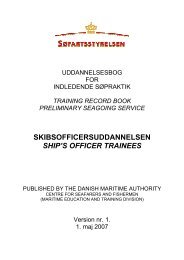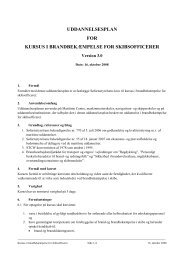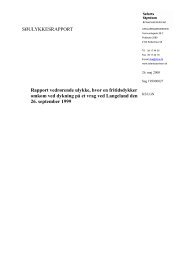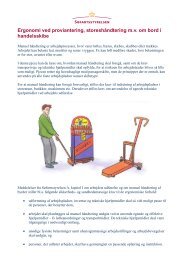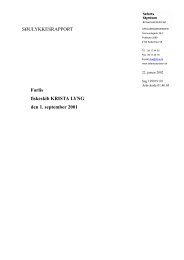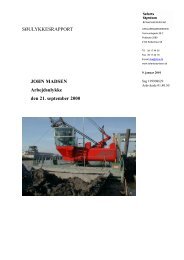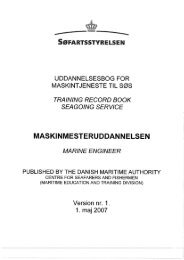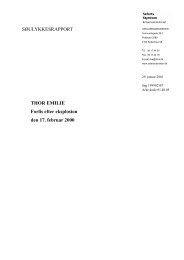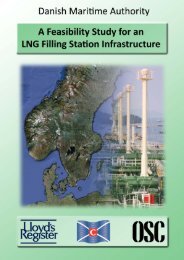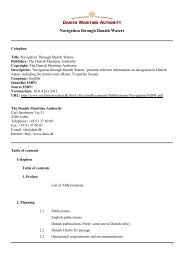Risk Analysis of Sea Traffic in the Area around Bornholm, 2008. - VTT
Risk Analysis of Sea Traffic in the Area around Bornholm, 2008. - VTT
Risk Analysis of Sea Traffic in the Area around Bornholm, 2008. - VTT
- No tags were found...
You also want an ePaper? Increase the reach of your titles
YUMPU automatically turns print PDFs into web optimized ePapers that Google loves.
<strong>Risk</strong> <strong>Analysis</strong> for <strong>Sea</strong> <strong>Traffic</strong> <strong>in</strong> <strong>the</strong> <strong>Area</strong> <strong>around</strong> <strong>Bornholm</strong><br />
11<br />
3 Limits <strong>of</strong> <strong>the</strong> <strong>Analysis</strong><br />
3.1 Scope<br />
3.1.1 Accidents<br />
The scope is limited to those types <strong>of</strong> ship accidents that are directly dependent<br />
on <strong>the</strong> local situation and that can be expected to be affected by a change <strong>in</strong> <strong>the</strong><br />
sea route system. This is typically <strong>the</strong> case for collisions and ground<strong>in</strong>gs, while<br />
not be<strong>in</strong>g <strong>the</strong> case for fires on board, system failure and similar events.<br />
Parallel collisions<br />
Cross<strong>in</strong>g collisions<br />
Powered ground<strong>in</strong>gs<br />
Drift ground<strong>in</strong>gs<br />
Accidents <strong>in</strong>volv<strong>in</strong>g<br />
small vessels<br />
This collision type concerns all ships that are sail<strong>in</strong>g on a parallel or almost<br />
parallel course, as it can be observed along sea routes. There are two types <strong>of</strong><br />
parallel collisions, i.e. head-on and overtak<strong>in</strong>g collisions.<br />
All o<strong>the</strong>r collisions between two mov<strong>in</strong>g vessels are classified as cross<strong>in</strong>g<br />
collisions.<br />
If a ship runs aground or ashore despite <strong>of</strong> fully operational propulsion and<br />
rudder systems, <strong>the</strong> event is referred to as powered ground<strong>in</strong>g. The study differentiates<br />
between two types <strong>of</strong> powered ground<strong>in</strong>gs: Those that are due to<br />
imprecise navigation and those that occur if bridge personnel are unable to follow<br />
<strong>the</strong>ir duty over a prolonged period, lead<strong>in</strong>g to a head-on collision with a<br />
ground or coast. This second ground<strong>in</strong>g type is typically due to alcohol, sleep,<br />
sudden disease or various distractions. A failure <strong>of</strong> <strong>in</strong>formation systems may<br />
equally have an effect here.<br />
This ground<strong>in</strong>g type occurs due to w<strong>in</strong>d and wave action after system failure on<br />
board <strong>of</strong> <strong>the</strong> vessel. It is critical mostly <strong>in</strong> very narrow navigational channels,<br />
such as Øresund, where a ship drifts aground after a comparatively short time.<br />
This cannot be compared to <strong>the</strong> area <strong>around</strong> <strong>Bornholm</strong>, where <strong>the</strong>re is much<br />
more space. Drift ground<strong>in</strong>gs are <strong>the</strong>refore not <strong>in</strong>vestigated <strong>in</strong> <strong>the</strong> study.<br />
The above models are based on traffic data obta<strong>in</strong>ed through <strong>the</strong> Automatic<br />
Identification System (AIS). Only ships with 300 gross tons and more are<br />
obliged to use AIS devices, although some m<strong>in</strong>or ships also do. Available data<br />
is <strong>the</strong>refore much more limited for small vessels, which ma<strong>in</strong>ly <strong>in</strong>clude fish<strong>in</strong>g<br />
boats and yachts (see traffic data description <strong>in</strong> chapter 4.2).<br />
P:\65775A\3_Pdoc\DOC\P-65775A ma<strong>in</strong> report f<strong>in</strong>al corr prepared for PDF.DOC<br />
.




